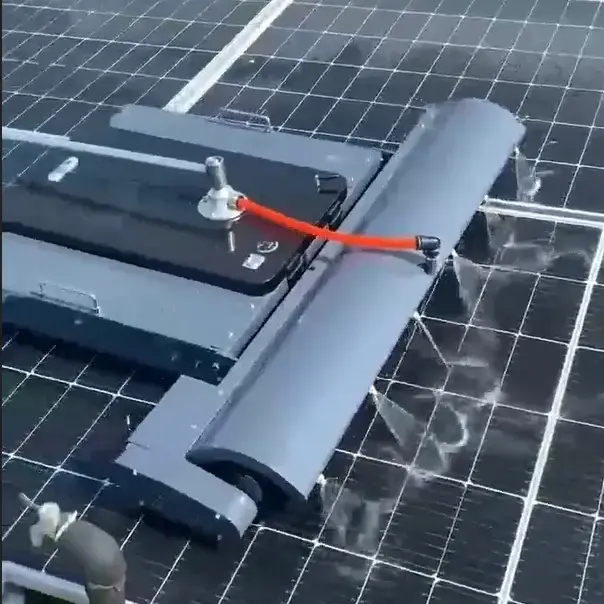How to Make Solar Panel Cleaning System
Solar panels are a remarkable investment in renewable energy, but their efficiency can drop significantly when covered with dust, dirt, and debris. Studies show that soiled panels can lose up to 30% of their energy output, particularly in arid regions like the Arabian Peninsula and northern India. Building an effective solar panel cleaning system is essential for maintaining optimal performance and maximizing your return on investment.
Understanding the Core Components
Creating a solar panel cleaning system requires careful consideration of several key components that work together to deliver efficient, safe, and reliable cleaning performance.
1. Cleaning Mechanism Design
The heart of any Solar Panel Cleaning system lies in its cleaning mechanism. Most effective systems utilize specialized brushes that can handle different types of contamination:
Spiral Brush Configuration: The most effective designs employ spiral cleaning brushes made from ultra-flexible modified nylon materials. These brushes rotate at adjustable speeds between 60 to 120 RPM, depending on the type of dust and weather conditions. The spiral design ensures comprehensive coverage while protecting the delicate photovoltaic module glass from scratches.
Dual Cleaning Modes: Modern systems incorporate both dry cleaning and wet washing capabilities. This flexibility allows operators to choose the most appropriate method based on the type of contamination and water availability.
2. Mobility and Navigation System
The movement system determines how effectively your cleaning solution covers the entire solar array:
Track-Based Systems: For fixed installations, track-based systems provide reliable movement along predetermined paths. These systems typically achieve walking speeds of around 12 meters per minute and can handle obstacle crossing angles up to 22 degrees.
Robotic Platforms: Advanced Solar Panel Cleaning Robot designs incorporate vacuum suction cups and ultrasonic sensors for stable navigation across panel surfaces. Four downward-looking ultrasonic sensors help maintain proper positioning and detect panel edges.
3. Power Management
Sustainable power solutions are crucial for autonomous operation:
Solar Charging Integration: Incorporate dedicated photovoltaic panels (typically 55W) with MPPT (Maximum Power Point Tracking) charging algorithms. This allows the system to recharge quickly, often achieving full battery recovery within 2 hours.
Battery Selection: Use lithium iron phosphate batteries with low-temperature formulas that can operate in extreme conditions (-20°C charging, -40°C discharging). A 24V/16Ah battery configuration typically provides 3 hours of continuous operation.
Building the Control System

The intelligence of your cleaning system lies in its control architecture:
Remote Monitoring and Control
Implement a multi-layered control system that includes:
- Internet remote control capabilities through 4G connectivity
- Mobile app control for convenient operation
- Manual override options for direct intervention
- Real-time monitoring with camera integration (where required)
Intelligent Scheduling
Program your system with smart scheduling features that consider:
- Environmental conditions and dust accumulation rates
- Time-of-day optimization to avoid peak generation hours
- Automatic return-to-base functionality when battery levels are low
- Breakpoint continuation for interrupted cleaning cycles
Essential Safety Features
Safety considerations are paramount when designing systems that operate on electrical installations:
Electrical Protection
- IP65-rated enclosures for all electrical components
- Proper grounding and insulation to prevent electric shock
- Emergency stop mechanisms accessible via remote control
Operational Safety
- Self-diagnostic systems with fault detection and alarm functions
- Automatic work logs and fault detail recording
- Visual AI correction for cleaning path optimization
Advanced Features for Professional Systems
Professional-grade systems developed by companies like Todos incorporate sophisticated features that enhance performance and reliability:
Self-Cleaning Programs
After each cleaning cycle, the system should execute a self-cleaning routine where brushes spin at high speed to remove accumulated dust, extending brush lifespan significantly.
Environmental Adaptation
Design your system to operate effectively across a wide temperature range (-30°C to 70°C) and various weather conditions. This ensures year-round functionality regardless of climate challenges.
Water Conservation
For wet cleaning modes, implement water-saving technologies that optimize consumption while maintaining cleaning effectiveness. Some advanced systems can operate with minimal water usage or utilize recycled water systems.
Implementation Considerations
Scalability
Design your system with modularity in mind, allowing for easy expansion as solar installations grow. Consider different configurations for:
- Ground-mounted solar farms
- Rooftop installations
- Floating solar arrays
- Agrivoltaic systems
Maintenance Planning
Build in features that simplify maintenance:
- Easy brush replacement mechanisms
- Accessible battery compartments
- Modular component design for quick repairs
- Comprehensive diagnostic reporting
Performance Monitoring
Implement data collection systems that track:
- Cleaning frequency and duration
- Energy consumption patterns
- Cleaning effectiveness metrics
- Equipment health indicators
Cost-Benefit Analysis
When developing your solar panel cleaning system, consider the economic implications:
Labor Cost Reduction: Automated systems eliminate the need for manual cleaning crews, significantly reducing operational expenses over time.
Energy Yield Improvement: Regular automated cleaning can maintain panel efficiency at optimal levels, potentially increasing energy output by 15-30% compared to uncleaned panels.
Equipment Longevity: Consistent cleaning prevents long-term damage from accumulated dirt and debris, extending panel lifespan and reducing replacement costs.
Future-Proofing Your Design
As technology evolves, ensure your cleaning system can adapt:
- Include provisions for AI and machine learning integration
- Design communication protocols that support future IoT enhancements
- Build in capacity for sensor upgrades and additional monitoring capabilities
- Consider compatibility with emerging solar panel technologies
Conclusion
Creating an effective solar panel cleaning system requires careful integration of mechanical, electrical, and intelligent control systems. By focusing on reliability, efficiency, and safety, you can develop a solution that maintains optimal solar panel performance while reducing operational costs and environmental impact. Whether building a simple track-based system or a sophisticated autonomous robot, the key lies in understanding your specific needs and designing a system that addresses them comprehensively.
The investment in a well-designed cleaning system pays dividends through improved energy generation, reduced maintenance costs, and extended equipment life. As solar energy continues to play a crucial role in our sustainable future, efficient cleaning systems become increasingly vital for maximizing the potential of this clean energy technology.
